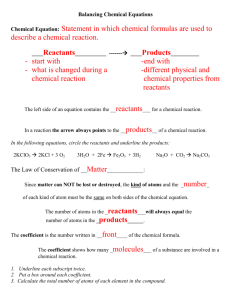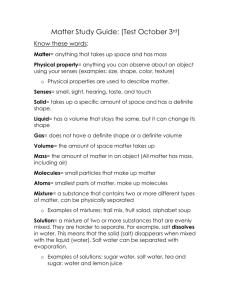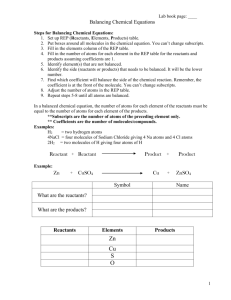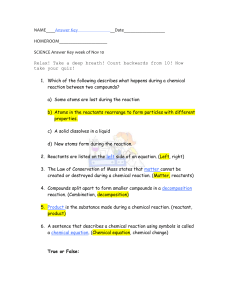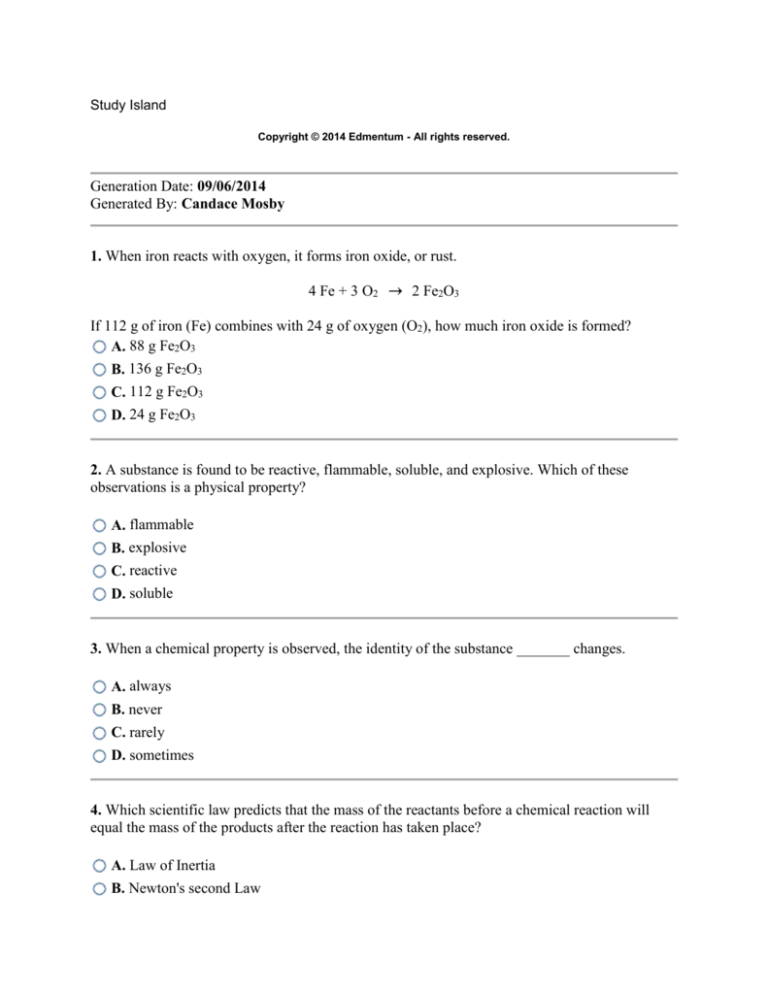
Study Island
Copyright © 2014 Edmentum - All rights reserved.
Generation Date: 09/06/2014
Generated By: Candace Mosby
1. When iron reacts with oxygen, it forms iron oxide, or rust.
4 Fe + 3 O2
2 Fe2O3
If 112 g of iron (Fe) combines with 24 g of oxygen (O2), how much iron oxide is formed?
A. 88 g Fe2O3
B. 136 g Fe2O3
C. 112 g Fe2O3
D. 24 g Fe2O3
2. A substance is found to be reactive, flammable, soluble, and explosive. Which of these
observations is a physical property?
A. flammable
B. explosive
C. reactive
D. soluble
3. When a chemical property is observed, the identity of the substance _______ changes.
A. always
B. never
C. rarely
D. sometimes
4. Which scientific law predicts that the mass of the reactants before a chemical reaction will
equal the mass of the products after the reaction has taken place?
A. Law of Inertia
B. Newton's second Law
C. Law of Conservation of Mass
D. Newton's Third Law
5. The best way to remove the mud from a sample of lake water is by
A. sorting.
B. filtration.
C. chromatography.
D. magnet.
6. Respiration describes the process that living cells use to release energy by combining sugar
and oxygen. The primary chemical changes that happen during respiration are shown in the
equation below.
Which statement correctly compares the reactants and products of the equation?
The mass of the reactants is the same as the mass of the products.
A.
B.
C.
D.
The mass of the reactants is less than the mass of the products.
The mass of the reactants is greater than the mass of the products.
The number of reactant molecules is greater than the number of products.
7. Edgar is stranded on an island surrounded by an ocean of salt water. He is thirsty, but he
knows that it is a bad idea to drink salt water.
How could Edgar separate the salt out of the salt-water mixture?
A. use chromatography
B. pour the mixture through a screen
C. evaporate off the water
D. use a magnet to attract the salt
8. In a chemical reaction, the total mass of the reactants is 10.0 grams. After the reaction, the
total mass of the products must be:
A. less than 10.0 grams.
B. more than 10.0 grams.
C. exactly 20.0 grams.
D. exactly 10.0 grams.
9. Which statement describes a physical change?
A. Sodium metal reacts explosively with oxygen.
B. Iron combines with oxygen to form rust.
C. Lead is heated and becomes more viscous.
D. Calcium is added to acid and hydrogen gas is produced.
10. An aluminum can is crushed.
The _______ of the can changed, but its _______ stayed the same.
A. color; mass
B. mass; color
C. shape; composition
D. composition; shape
11. A change in a physical property of matter can indicate
A. neither a physical nor a chemical change.
B. a physical change only.
C. a chemical change only.
D. a physical change or a chemical change.
12. Mrs. Clark decides to do a demonstration for her class with a piece of notebook paper. Using
a balance, Mrs. Clark discovers that the mass of the paper is 20 g. She then takes the piece of
paper and cuts it into several small pieces. The cumulative mass of the small pieces is 20 g. What
has Mrs. Clark demonstrated for her class?
A.
B.
C.
D.
a physical change involving change of mass
a chemical change involving change of mass
a physical change involving change of shape and size of matter
a chemical change involving change of shape and size of matter
13. A piece of metal is dropped into a solution of acid. Using a sharp probe, the metal is broken
into smaller pieces while in the solution. Also while in the solution, some of the metal reacts,
producing hydrogen gas. Which statement is true about the changes that have occurred?
A. Only chemical changes have occurred.
B. No physical or chemical changes have occurred.
C. Physical and chemical changes have occurred.
D. Only physical changes have occurred.
14. A cube of sodium chloride—which is table salt—is soluble in water.
A _______ property of salt is that it will _______ in water.
A. physical; dissolve
B. chemical; sink
C. physical; corrode
D. chemical; dissolve
15. When a substance undergoes a physical change,
A. its color always changes.
B. its composition remains the same.
C. its composition always changes.
D. its mass always decreases.
16. Ethanol contains the elements carbon, hydrogen, and oxygen. When ethanol burns, it
chemically reacts with oxygen gas.
C2H6O +
O2
ethanol
oxygen gas
What elements will be present in the substances that are created when ethanol burns?
A. the elements cannot be determined
B. nitrogen, sulfur, and sodium only
C. carbon and hydrogen only
D. carbon, hydrogen, and oxygen only
17. Gasoline is a substance that is used to power automobiles. Gasoline will oxidize in air.
A _______ property of gasoline is that it will _______ in air.
A. chemical; burn
B. chemical; evaporate
C. physical; corrode
D. physical; explode
18. A solution of salt water is boiled. The water evaporates and solid salt remains. Which
statement is true?
A.
B.
The salt and the water have both undergone physical changes.
The salt and the water have both undergone chemical changes.
The salt has undergone a chemical change, and the water has undergone a physical
C. change.
The salt has undergone a physical change, and the water has undergone a chemical
D. change.
19. Mario places 10 mL of water in a test tube and heats the liquid over a Bunsen burner for
2 minutes. After removing the test tube from the Bunsen burner, there are 6 mL of water left in
the test tube. This experiment is a good example of a
A. physical change involving phase changes.
B. physical change involving chemical reactions.
C. chemical change involving chemical reactions.
D. chemical change involving phase changes.
20. Sasha wanted to make a cake, but her flour had lumps in it. How could Sasha remove the
lumps from the rest of the flour?
A. by boiling the flour
B. with a magnet
C. with a screen
D. with chromatography
21. A chemical reaction involves the rearrangement of atoms to form new molecules. During a
chemical reaction, however, atoms are neither created nor destroyed.
Which of the following is true about the atoms involved in a chemical reaction?
The total mass of the atoms involved in a chemical reaction will increase if a new
A. compound is formed during the reaction.
The total mass of the atoms involved in a chemical reaction will stay the same no matter
B. how the atoms are rearranged.
The total mass of the atoms involved in a chemical reaction always changes as the atoms
C. are rearranged into new molecules.
The total mass of the atoms involved in a chemical reaction will decrease if two molecules
D. combine to form one single compound.
22. In which of the following situations would mass be conserved?
A.
B.
C.
D.
An uncovered pot of water is brought to a boil.
A log burns in an outdoor fire pit.
An open container of baking soda has vinegar added to it.
A wax candle burns while in a sealed jar.
23. Twenty-four grams of magnesium metal reacts with sixteen grams of oxygen gas to form
magnesium oxide. According to the law of conservation of mass, how much magnesium oxide
will there be after the chemical change is complete?
A. 24 g
B. 30 g
C. 40 g
D. 16 g
24. Jeannie dropped a solid object into a beaker of water and observed it for five minutes. Based
on her observations, she determined that only a physical change occurred.
Which of the following observations would indicate that only a physical change occurred after
she added the object?
A.
The object sank to the bottom when dropped into the glass of water.
Bubbles formed around the object as it sank to the bottom of the water and did not
B. resurface.
C.
D.
The object broke apart and seemed to disappear when dropped into the glass of water.
The object floated on the top of the water when when dropped into the glass.
25. Which of the following statements describes a physical property?
A.
B.
C.
D.
The substance forms a solid when reacted with silver nitrate.
The substance is highly reactive.
The substance produces an acid when dissolved in water.
The substance has a higher density than water.
26. In the chemical reaction below, calcium metal and water react to form calcium hydroxide and
hydrogen gas .
calcium metal + water → calcium hydroxide + hydrogen gas
Calcium and water are the reactants in this chemical reaction, whereas calcium hydroxide and
hydrogen gas are the products that are formed. Once the reaction reaches completion,
the products of the reaction will have changed back into the reactants.
A.
B.
C.
D.
the total mass of the products will be equal to the original mass of the reactants.
the total mass of the products will be less than the original mass of the reactants.
the total mass of the products will be greater than the original mass of the reactants.
27. A sieve is a container with a mesh or perforated bottom.
What is the most common use for a sieve?
A. to store liquid substances
B. to steam cook chemicals in the lab
C. to filter larger particles out of a mixture
D. to allow gases to escape from reactions
28. According to the law of conservation of matter, the number of ________ is not changed by a
chemical reaction.
A. products
B. atoms
C. molecules
D. bonds
29. Which of the following is true about the mass of the reactants in a chemical reaction?
The total mass of the reactants in a chemical reaction will be significantly less than the
A. total mass of the products.
The total mass of the reactants in a chemical reaction will be significantly more than the
B. total mass of the products.
The total mass of the reactants in a chemical reaction will never be equal to the total mass
C. of the products.
The total mass of the reactants in a chemical reaction is conserved and will be equal to the
D. total original mass of the products.
30. In atomic theory, new substances are formed when the atoms of other substances are
rearranged. In this kind of change, the total number of atoms is conserved.
An example of this is shown in the diagram below. There are six atoms both before and after the
arrow.
Which statement below is also true of the rearrangement of atoms?
A. The amount of matter is conserved.
B. The number of substances increases.
C. The amount of matter decreases.
D. The number of substances is conserved.

